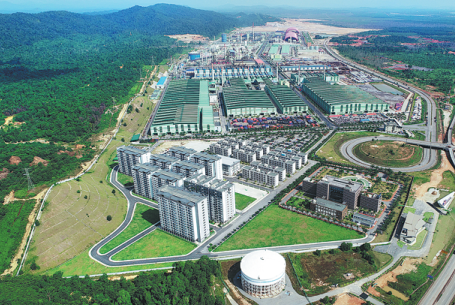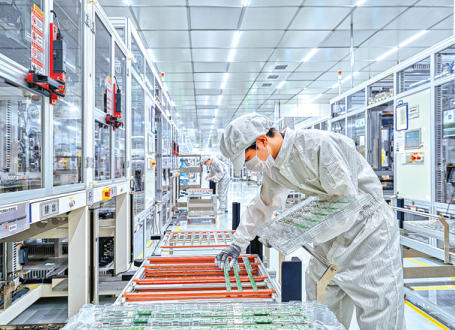Guangxi boosts opening-up under RCEP
Autonomous region is a key transport hub in country's western land-sea corridor
Adjacent to Guangdong province, Hong Kong and Macao special administrative regions and connecting Southeast Asia, the Guangxi Zhuang autonomous region, a transport hub and key part in China's western land-sea corridor, has boosted opening-up and high-quality development under the Regional Comprehensive Economic Partnership agreement.
The Pinglu Canal, one of the major projects of China's new western land-sea corridor, began construction on Aug 28 in Qinzhou city, Guangxi.
Running 135 kilometers, the canal will start at Xijin Reservoir in Hengzhou and end in Luwu town in Lingshan county, where ships will be able to reach the Beibu Gulf via the Qinjiang River.
The canal marks China's first combined transport channel that is expected to bring multiple benefits across the economy, society, ecology and other aspects.
The construction of the Pinglu Canal will form a convenient waterway for trade between China and Association of Southeast Asian Nations.
It is of great significance to promoting the construction of the new western land-sea corridor and the pilot project helps the region further integrate into the new development pattern and accelerate high-quality regional economic growth.
According to statistics from China State Railway Group, in the first eight months of this year, a total of 498,600 twenty-foot equivalent units of goods were transported by rail-sea combined train on the new western land-sea corridor, a year-on-year increase of 26.8 percent.
Based on its geographical advantages, Guangxi continues to connect with the 21st Century Maritime Silk Road and the Silk Road Economic Belt.
On May 18, 2021, Guangxi's first direct cargo route from Liuzhou to Moscow, Russia, was launched. The total export volume of the cross-border trains has reached 2,214 TEUs, a total of 19,700 metric tons.
In recent years, Guangxi has focused on building a new platform for all-around opening-up to the outside world with the Beibu Gulf Port, which comprises the ports of Qinzhou, Fangcheng and Beihai and serves as an important transit point in the new land-sea corridor.
Beibu Gulf Port has a total of 71 domestic and foreign trade container routes, including 43 foreign trade container routes and 33 routes connecting to the ports of RCEP member countries, essentially achieving full coverage of major ports in Southeast and Northeast Asia.
Zheng Zuoliang, a Brunei businessman, is a frequent visitor to the Qinzhou Port's east station in the north of Guangxi.
He introduced Brunei's shrimp chips, coffee and other products to the Chinese market, and at the same time, promoted Chinese citrus and other products to ASEAN members.
"Our company's cargo ships depart from Brunei Port to Qinzhou Port in Guangxi, and then transfer to the railway from here to Chongqing, and Sichuan and Yunnan provinces," Zheng said.
"Now, the business is becoming more prosperous, and we will consider expanding the category of goods in the future."
After the RCEP came into effect, the new land-sea corridor in western China has been increasingly attractive and more ASEAN merchants are using this corridor to carry out international trade.
Guangxi will strengthen its linkage with the Guangdong-Hong Kong-Macao Greater Bay Area and Hainan Free Trade Port to comprehensively promote the land-sea corridor and attract more investment, enterprises and talented people.
From January to August this year, the total investment of newly signed projects from enterprises in the Bay Area to Guangxi reached 304.1 billion yuan ($42.4 billion) and the capital in place for investment promotion was 231.1 billion yuan.
The establishment of the China (Guangxi) Pilot Free Trade Zone is a landmark in the region's opening-up.
In August 2019, the State Council announced the establishment of six new pilot free trade zones including Guangxi to achieve full coverage of China's pilot free trade zones in coastal areas.
Guangxi has attracted a slew of leading enterprises, driving the rapid development of industries such as electronic information, high-end equipment manufacturing, new energy and new materials.
As of July, a total of 76,000 enterprises have settled in the trade zone.
Guangxi has also continued to promote the interconnection of cross-border infrastructure in border areas and facilitated the customs clearance at border highway ports and airports.
The overall customs clearance time of Guangxi ports has been shortened from nearly 57 hours in 2017 to less than six hours in 2021, ranking fastest in the country for two consecutive years.
The inspection facilities at the Youyiguan Port are constantly being upgraded.
A new chapter
In the new energy vehicle exhibition area of the 19th China-ASEAN Expo, a Wuling Hongguang MINI EV convertible became the focus of the audience.
Exhibitor surnamed Xia said the car's debut at the 2021 Shanghai Auto Show sparked passionate discussions as the price was less than 100,000 yuan.
Wuling explored overseas markets and achieved remarkable results. Statistics show that as of July, SAICGM-Wuling exported a cumulative sales volume of 105,643 units, a year-on-year increase of 21 percent, covering more than 40 countries and regions in Central and South America, the Middle East, Africa and Southeast Asia.
A few days ago, SAIC-GM-Wuling's Digital Supply Chain Collaborative Intelligent Manufacturing Cloud Platform was listed as a pilot demonstration project for the integrated development of manufacturing and the internet by the Ministry of Industry and Information Technology.
It has been promoted and applied among 700 suppliers.
According to the Guangxi High-Quality Implementation RCEP Action Plan (2022-25), Guangxi will expand the import scale of advanced equipment and technologies such as auto parts from Japan and South Korea while expanding the import of commercial vehicles, passenger vehicles and special vehicles from ASEAN members.
Guangxi has vigorously implemented its innovation-driven development strategy and taken strong initiative in technical fields.
The data show that the Beibu Gulf Big Data Exchange Center has listed 193 data products, with a transaction scale of 69 million yuan.
The credit data of 7 million overseas companies provide in-depth data query services for nearly 30,000 foreign trade companies in China.
Guangxi is increasing its efforts in opening-up and cooperation and deepening cooperation with ASEAN members in technology transfer and scientific and technological exchanges.
The region's China-ASEAN Technology Transfer Center has established inter-governmental bilateral technology transfer working mechanisms with nine ASEAN members including Thailand and Laos, a technology transfer joint working group with seven ASEAN countries as well as a technology transfer collaboration network with 2,619 members.
During the 19th China-ASEAN Expo, 267 investment cooperation projects were signed, with a total investment of 413 billion yuan, an increase of 37 percent over the previous session.
Guangxi will further consolidate and expand the important achievements of the current China-ASEAN Expo and seize opportunities to build a comprehensive strategic partnership with ASEAN members.

The picturesque view from the top of Gupo Mountain in Hezhou city, the Guangxi Zhuang autonomous region. CHINA DAILY

The China-Malaysia Qinzhou Industrial Park in Guangxi opens in 2012. CHINA DAILY

Workers check facilities at Huike Electronics' Beihai branch in Guangxi. CHINA DAILY
